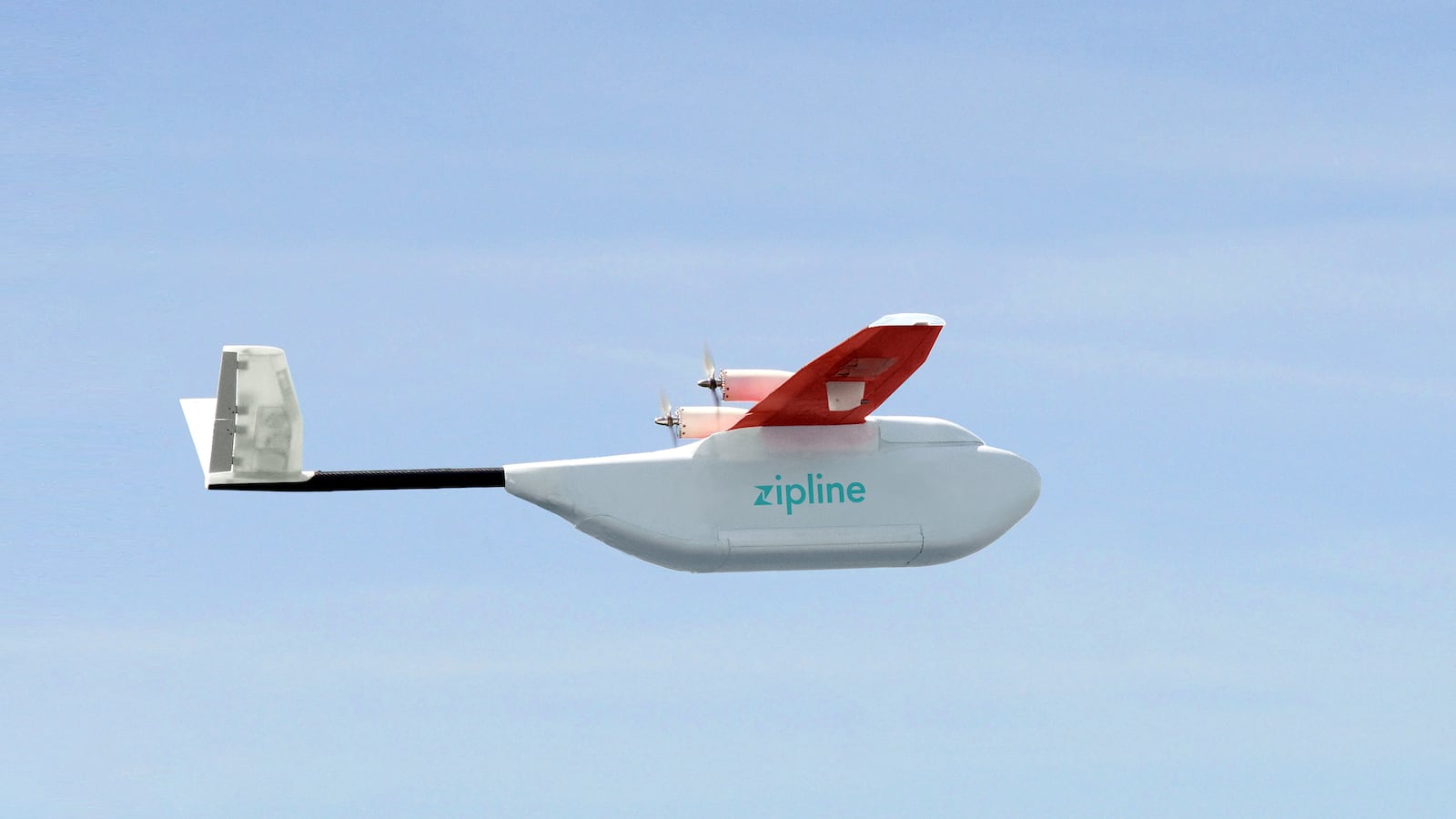Inside this tiny plane in wet, windy California sits a bunch of blood.
It looks like one of those RC doohickeys, and it can only handle 3 1/2 pounds of the stuff, but it’s an RC doohickey that’s going to save a lot of lives in Rwanda in a couple of months and maybe, down the line, it’s going to piss off Amazon.com.
We’ll get to that last part in a second.

The tiny plane is made by Zipline, a California startup backed by some of the biggest names a California startup can be backed by: Google Ventures, Sequoia Capital, Stanford University, Microsoft cofounder Paul Allen, and, among others, Yahoo founder and Alibaba chairman Jerry Yang.
On Friday, The Daily Beast watched the thing take off during a private demo on Periscope in front of Zipline CEO Keller Rinaudo. It’s a drone that takes off from a diagonal ramp like a catapult. When those ramps are set up in a strategically placed launch areas all throughout Rwanda over the next year, the plane will be able to deliver blood to any place in the country in 15 minutes.
In short, these are the drones that are—at last—going to save a lot of lives. And they are going to save a lot of mothers and children.
According to the Zipline’s research, 50 percent of blood transfusions in Rwanda goes to mothers suffering from postpartum hemorrhaging. Thirty percent of that blood goes to children suffering from malaria.
But those people are often hard to get to. Trucks, motorcycles, and cars take a lot of time that medical emergencies often don’t have. And when it rains?
“Roads are washed out 95 percent of the time in the rainy season,” said Rinaudo. These things are created to fly in inclement weather.
Drones can look stupid affixed to a GoPro in the U.S. and snuff out plenty of lives in Iraq and Syria, but these will start to save some.
“There’s a really, really clear need,” said Rinaudo. “A lot of governments are taking a big gamble working with us and working out the regulatory issues that are required to make this possible. But we know this can make a huge difference. It’s really as simple as having a database of people where—you know their lives are in danger, but can you get them what they need fast enough?”
Zipline brought together a staff of ex-NASA, Boeing, SpaceX, and Google brains to figure it out. They’re all in a field testing it. Once the drone shoots off, an app on an iPad watches it speed to a drop-off area, where the blood—packaged so it won’t explode—is ejected to a place where it can have a safe landing.
The app even accounts for wind at the package’s drop-off site. Actually, everything’s accounted for, says Rinaudo.

“We had to move fast—to iterate on a product 10 times faster than Boeing and Airbus. So we do everything in one place,” he said. “We lay out the boards. We write the firmware for the avionics. We write all the software, like the air traffic control. We design vehicles from scratch. We manufacture and test and fly vehicles in one place. We’re able to communicate fast and solve problems fast.”
That’s how they got Rwanda to sign off. Zipline is working directly with the government for its first deployment in July. They want to make what’s known as last-mile deliveries—effectively being the local postman—for more than half of the country’s blood deliveries.
First, they have to work with people to make sure the average person isn’t freaked out by the weird robot operating well below the commercial aviation floor, sometimes around 300 feet. They’re talking to community leaders, putting out fliers and PSAs over the radio, and even scheduling meet-ups with locals on the country’s traditional day of community service that happens every month.
Then, eventually, they want to take this thing to your backyard.
“Is it possible in the U.S.? Absolutely, yes, but I can’t control the FAA,” said Rinaudo. “It certainly is the case that the U.S. has one of the most complicated airspaces in the world—and the FAA is even more risk-averse than most regulators.”
Instead, Rinaudo said, “This will start in environments where the need is very high but the airspace is relatively empty. [But] it’s only a matter of time before you see this tech adopted in middle-income countries.”
And that’s why you should keep an eye out for one of the company’s largest investors, Alibaba chairman Jerry Yang. The tech giant, which received a $60 billion valuation last year, effectively serves as the Amazon of Asia. Alibaba and Amazon are set to go toe-to-toe in the next few years as Indian e-commerce picks up.
You likely know of Amazon’s much publicized drone fetish. But Zipline could serve as a de facto successful pilot program—one that’s doing real, worldly good in Rwanda—and might give Alibaba a leg up on how to deliver small packages at scale. It will be first in line.
Rinaudo is dead set on this tech—and the $18 million his company raised in venture capital funding—only being used for medicinal purposes now.
“We’re very specifically focused on this specific market. We could grow exponentially for a decade in medicine and not focus on anything else,” he said.
But Zipline is a for-profit company. And when the FAA begins to relent to our robot future, companies that want to deliver much more less vital stuff will likely turn for help to Rinaudo and his crew, who have already poured their blood and sweat and blood into making it work.






